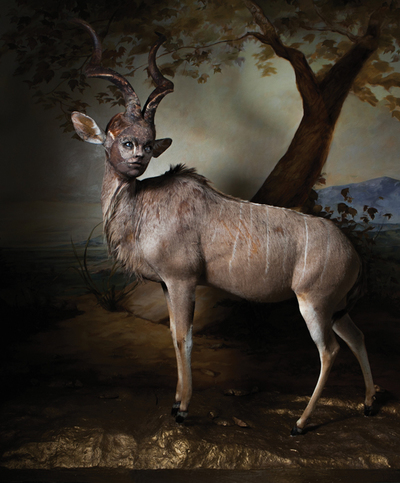Dead Animals, or the curious occurrence of taxidermy in contemporary art

Kate Clark, Licking the Plate, 2014, Kudu hide and horns, foam, clay, thread, pins, rubber eyes, wood, plaster, paint, and painted backdrop, 10 x 10 x 4′. Lent by the artist.
Not a creature is stirring in David Winton Bell Gallery’s latest offering, a collection of carcasses aptly titled Dead Animals, or the curious occurrence of taxidermy in contemporary art. The artists—including notable contemporaries like Maurizio Cattelan, Damien Hirst and Polly Morgan— refashion remains into exquisite forms prompting sometimes troubling questions. The results range from expectedly morbid to amusing and moving, with little regard for the sentimental or cuddly.
In the lobby, an appetizer of photography greets visitors on arrival, offering glimpses into more controlled and conventional taxidermy. But the menagerie just feet away inevitably stokes your curiosity. The elegant photographic compositions by Richard Barnes, Richard Ross and Sarah Cusimano Miles can feel auxiliary to the action nearby.
The main gallery space has several standouts—such as Kate Clark’s manimal Licking the Plate, or Nicholas Galanin’s mournful wolf—yet the show is equally weighted, with no clear center of attention. These are works of considerable thought and craft, each a distinctive approach to the aesthetic and critical capacities of taxidermy.
The most stylish inhabitants of this undead ecosystem are Deborah Sengl’s trio of fashion-forward forest dwellers. In Killed to Be Dressed, a fox, mink and stoat strut their latest acquisitions—purses, coats and accessories made of “human flesh” (actually wax). This gruesome hilarity feels like a reimagined fairy tale, where the oppressed animals take revenge by turning the abusive humans into posh handbags.
Angela Singer relates a grimmer and more urgent fable, unveiling the unnatural injuries that befell her subjects (gunshot wounds, scars). A dedicated animal rights activist, Singer works against the traditional aims of taxidermy, instead exposing the cruel and strange relationship between animals and humans. In Spurts, she creates a decapitated Bambi with a head wound gushing a pale shade of bubblegum-pink blood.
Unified by material, but not always in philosophy, the exhibiting artists probe a variety of concerns: animal rights, transhumanism, the precarious balance of life and death. The blend of real and unreal, breathing and breathless that makes taxidermy so captivating bolsters the verve of these inquiries. Even in death, the animal kingdom is not peaceable—yet it remains provocative and spectacular.
